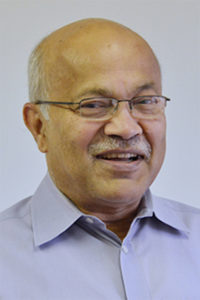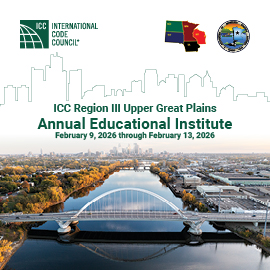
S.K. Ghosh Associates: A premier technical resource for the building safety industry
S.K. Ghosh Associates shares its expertise and thought leadership with the building safety community through year-round training, peer reviews, research projects and code interpretations
S. K. Ghosh Associates LLC (SKGA), part of the International Code Council’s family of solutions, provides seismic and code consulting services to a wide range of clients in the public and private sectors. Based in Palatine, Illinois, SKGA shares its expertise and thought leadership with the building safety community through year-round training courses, peer reviews, research projects, code interpretations and comparisons, webinars, and even a suite of innovative custom-made software solutions. Since its founding in 1998, SKGA’s customer service focus has been on building confidence, earning trust and exceeding expectations.
 Timeliness and relevance are also key drivers of the services the company offers. Following last year’s partial collapse of the Champlain Towers South condominium in Surfside, Florida, in which 98 people died, SKGA offered a four-part webinar series on the disaster, examining how American Concrete Institute standard ACI 318, “Building Code Requirements for Structural Concrete and Commentary” and its guidance on concrete and reinforcement durability, beamless slab design, and reinforcement detailing could have enhanced the building’s performance and made disproportionate collapse less likely. The webinars are available for purchase on the site.
Timeliness and relevance are also key drivers of the services the company offers. Following last year’s partial collapse of the Champlain Towers South condominium in Surfside, Florida, in which 98 people died, SKGA offered a four-part webinar series on the disaster, examining how American Concrete Institute standard ACI 318, “Building Code Requirements for Structural Concrete and Commentary” and its guidance on concrete and reinforcement durability, beamless slab design, and reinforcement detailing could have enhanced the building’s performance and made disproportionate collapse less likely. The webinars are available for purchase on the site.
S. K. Ghosh shares his expertise and thought leadership
SKGA founder and president Dr. S. K. Ghosh is an internationally known expert in earthquake engineering. His specialty is in the analysis and design of reinforced and prestressed concrete structures, particularly wind and earthquake resistance. His service on national technical committees and advisory panels has enabled him to put his experience to good use improving seismic design provisions for precast concrete structures in building codes throughout the United States.
In the 1980s, Dr. Ghosh developed a computerized procedure for predicting and compensating for the differential shortening of concrete columns and shear walls over time in multistory buildings. Dr. Ghosh based his procedure on research originally conducted by noted structural engineers Fazlur Kahn and Mark Fintel. “Unequal vertical shortening can result in non-level floors if the differential shortening is not compensated for,” Dr. Ghosh explained. “The computerized procedure was used for a long time by many design offices around the world.”
Given Dr. Ghosh’s expertise with computer modeling and simulation, it shouldn’t be a surprise that SKGA offers a suite of custom-made computer programs that clients can download from its website. The applications cover simplified wind design using ASCE 7, “Minimum Design Loads and Associated Criteria for Buildings and Other Structures,” the design of post-tensioned concrete floors and frames, anchor design for concrete per ACI 318 and for masonry per The Masonry Society standard TMS 402, and the design of concrete and masonry retaining walls.
Dr. Ghosh explained that SKGA branched out into computer programs in 2002, when ACI 318 first introduced design provisions for concrete anchors. “The design of anchors in concrete became much more complicated then,” Dr. Ghosh said. “We were getting way too many questions on anchor design by Appendix D. That led us to decide to write our first computer program, QuickAnchor.”
“Our programs provide our clients with design tools that are cost-effective, reliable, and easy to use,” he said. “Very importantly, most building departments do not question the results.”
Subject matter expert on seismic and concrete-related code provisions
Dr. Ghosh is an honorary member of the American Concrete Institute (ACI) and is a Fellow of the American Society of Civil Engineers (ASCE), the Structural Engineering Institute and the Precast/Prestressed Concrete Institute. He is a member of ACI Committee 318, Standard Building Code, and the ASCE 7 Standard Committee (Minimum Design Loads for Buildings and Other Structures). He is a former member of the board of directors of ACI, the Earthquake Engineering Research Institute and the Building Seismic Safety Council. He just completed a term as a member of the board of governors of ASCE’s Structural Engineering Institute.
Last year, the National Institute of Building Sciences honored Dr. Ghosh with a 2021 Building Seismic Safety Council Excellence Award for his contributions to “advancing seismic design and construction and improving the economic viability of building systems.”
Dr. Ghosh played a major role in introducing a rational shear wall design procedure into the 1994 Uniform Building Code, which was further improved in the 1997 edition. He was also influential in improving and expanding diaphragm design provisions in U.S. codes and standards, and in encouraging national codes and standards to recognize ductile coupled shear walls as distinct structural systems.
“Countless engineers since the early to mid- 80s have received information on changes to seismic and concrete-related code provisions from me,” Dr. Ghosh acknowledged.
Watching impactful changes in seismic design provisions
Over the course of his career, Dr. Ghosh has seen some impactful changes in seismic design provisions emerge from the committees and advisory panels that he has participated in or chaired. “The biggest change has been that in seismic design and detailing of a structure, we not only consider the seismic hazard, as we used to do, but also the soils underlying the foundation and the occupancy of the structure,” he said. “Other important changes have been improved design provisions for reinforced concrete shear walls and for diaphragms of various materials, which transmit seismic forces originating in the floor and roof slabs to the columns and shear walls that take them down to the foundation and the ground.”
During the last quarter-century, the building safety industry has also seen many changes in the design of wind- and earthquake-resistant structures — many of them fostered by Dr. Ghosh. In earthquake-resistant design, for example, “the biggest stride has been our ability to trace the history of response of a complex structure to recorded or artificially generated ground motions that are representative of the site, recognizing the fact that certain regions of certain structural members will be sustaining damage as the structure responds to these ground motions,” he said.
“In the area of wind-resistant design, the biggest stride has been our ability to more precisely estimate the design wind speeds, which are now a function of the occupancy of the structure, in hurricane-prone as well as non-hurricane regions,” Ghosh said. “The very latest development is the introduction of tornado-resistant design provisions in our design standard, ASCE 7.”
SKGA updates its schedule of webinar training all the time, so building safety professionals should be sure to check the site regularly to stay abreast of the latest developments in concrete construction, designing wind- and seismic-resilient structures, and much more. The range of professional resources available through SKGA demonstrate why it is has been, and remains, a leader in the field.
The ICC family of solutions is dedicated to providing businesses and municipalities with the tools they need to build safe, affordable, and sustainable communities and buildings. Through them, the Code Council offers codes and standards development, product testing and evaluation, accreditation, software and technology, professional development and training, and consulting services to its customers worldwide.






